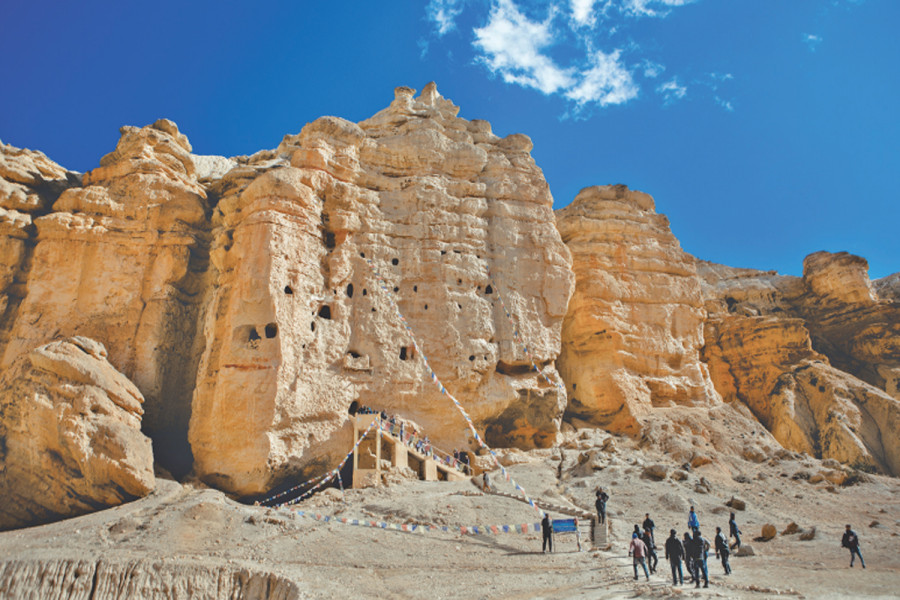National
Upper Mustang residents ‘ate nutritious diet long before modern civilisation’
National and international researchers say the tectonic shift in land masses caused by the 2015 Nepal earthquake revealed several caves that were hidden from their sight.
Post Report
Researchers on Monday said that people in the Upper Mustang, an ancient forbidden kingdom bordered by the Tibetan Plateau, had an extremely nutritious diet full of proteins and carbohydrates before the emergence of modern civilisation.
Presenting his findings on 15 years of ‘Interdisciplinary Archaeological Research in Upper Mustang’, Professor Mark Aldenderfer of the Department of Anthropology and Heritage Studies at the University of California, Merced said that the region had little violence among the communities.
Before coming to Nepal, Professor Aldenderfer researched various high-altitude areas around the world, including Ethiopia, the Andes, and the Tibetan Plateaus.
His team found evidence of human settlement in the area including Kyang, Rhirhi, Lubrak, Chokhopani, Samdzong, and Mebrak dating back to 800 BC.
Mustang is one of the few regions that has a recorded history of continuous permanent settlement from 1250 BC.
Aldenderfer’s team also presented their research from different areas of ancient DNA analysis.
Other researchers presented their findings on ancient DNA in Mustang, hinting towards a well-developed civilisation and cultural exchange in ancient times in the region.
American and Nepali researchers who have been working with Nepali research teams presented their analysis of the artefacts uncovered in various locations throughout Mustang and Manang.
They said that many artefacts in the region were lost during pipeline- and road-building projects. However, few have been preserved by Nepali archaeological scientists in museums in the National Museum and Tilaurakot Museum.
The cold climate and cliff caves preserved most of the habitats, artefacts, and ancient burial grounds.
According to the researchers, the tectonic shift in land masses caused by the 2015 Nepal earthquake revealed several caves that were hidden from the researchers’ sight, hence enabling archaeological research of the buried underground.
Christina Warriner, associate Professor of Anthropology at Harvard University, presented her research on the discovery of origins of various diseases through microscopic analysis of teeth of preserved human remains in various parts of the world.
She shared that the invention of new machines for genome sequencing has increased the speed of generating elaborate sequences to up to 10 billion sequences a day, a feat impossible until a decade ago.
Warriner emphasised the promotion of scientific curiosity in colleges and academic platforms to advance the study of ancient DNA to decode the origins of human diseases and develop their cures.
Several gold and silver masks that are common in the central and East Asian cultures indicate a strong influence from Tibet and the rest of Central Asia.
“There are also signs of long-distance travels from northern and southern India as demonstrated by artefacts of distinctively designed copper vessels, bamboo and rice, foodstuffs that do not grow in such high altitudes,” said Warinner.
According to her research, human and microorganism evolution at Manang and Mustang present evidence of well-developed travel routes and cultural influences from both neighbouring Tibetan and central Asia region as well as distant southern India which presents a unique case of ancient history in the region.
There have been discoveries of routes connecting Mustang to Ladakh and even the central Tibetan plateau.
Ju Heon Lee from Seoul National University presented her findings from the study of the Genetic history of Tibetan and Tibetan Burman people.
Nepali archaeological researchers Professor Suchitra Thapa of Tribhuvan University and other international researchers Megan Michel and Maxime Borry also presented their papers at the symposium.
“Antibiotic resistance in Upper Mustang is also ancient,” said Devraj Joshi, associate professor at the Central Department of Microbiology, Tribhuvan University. “Our research has shown that pollution and human activities have also caused antibiotic resistance in the environment.”




 5.62°C Kathmandu
5.62°C Kathmandu







%20(1).jpg&w=300&height=200)





